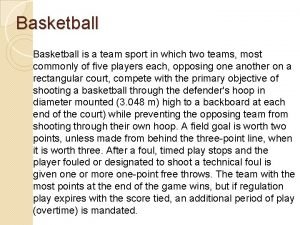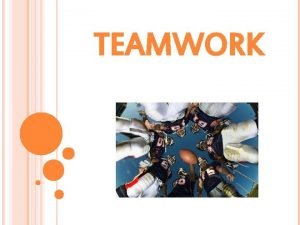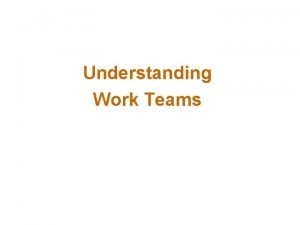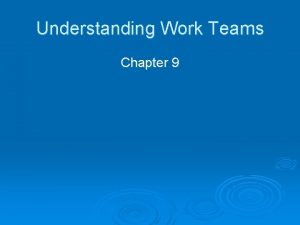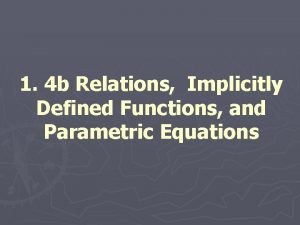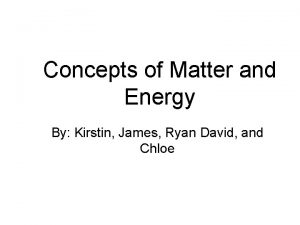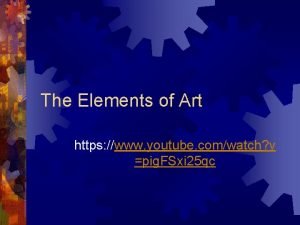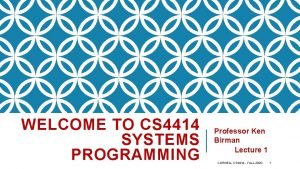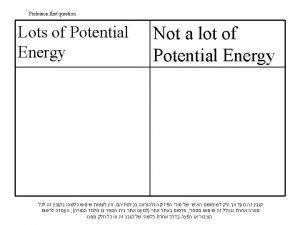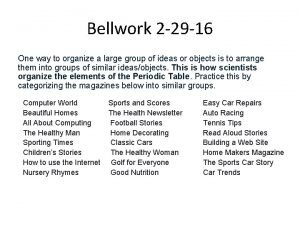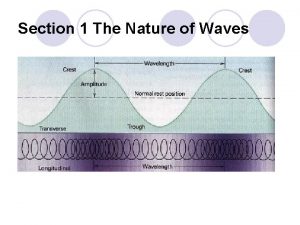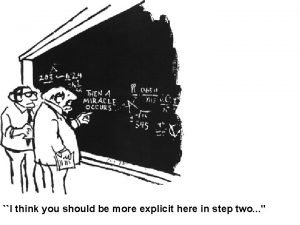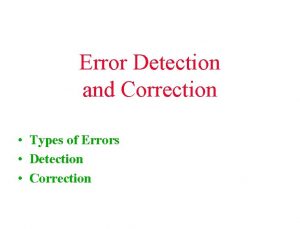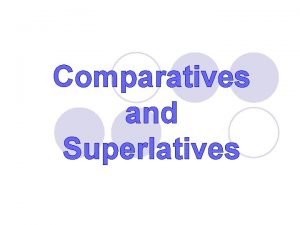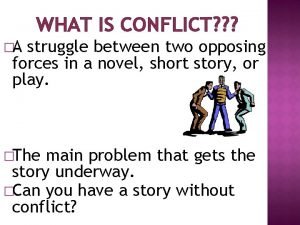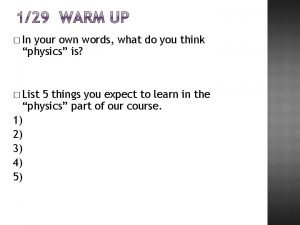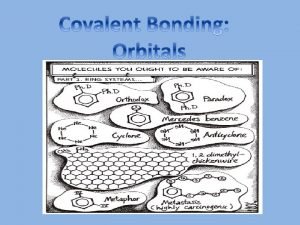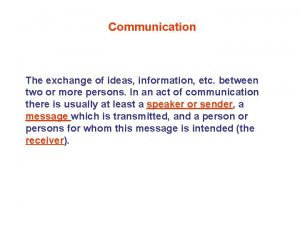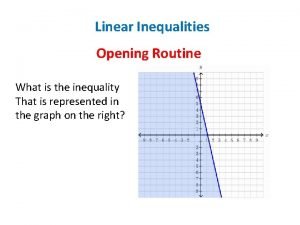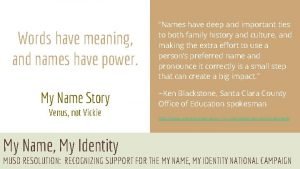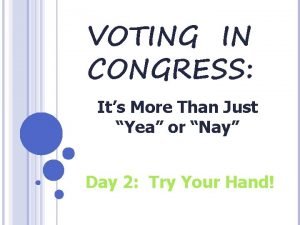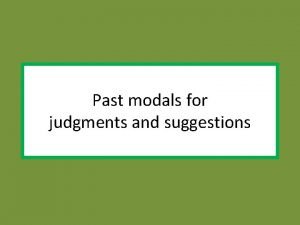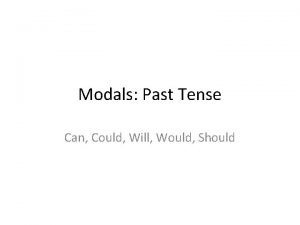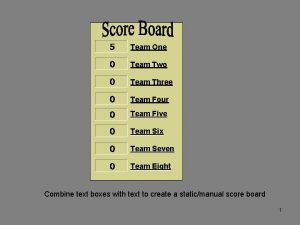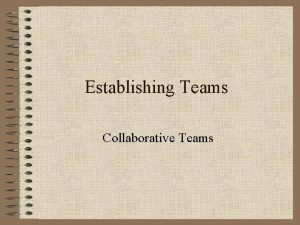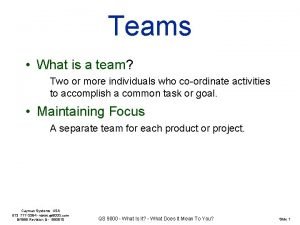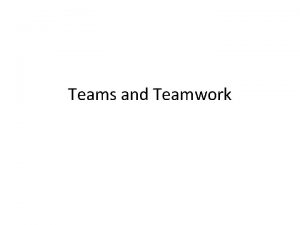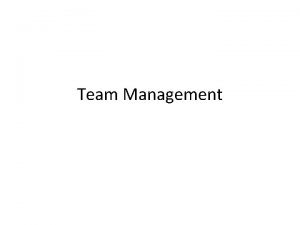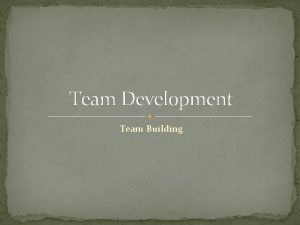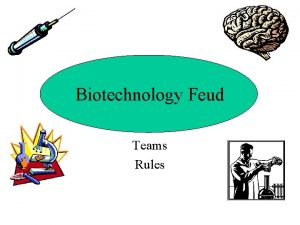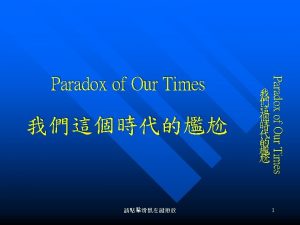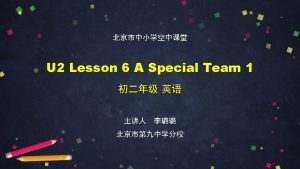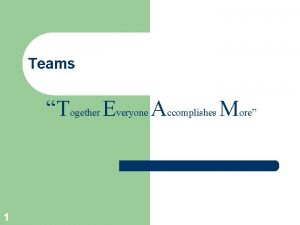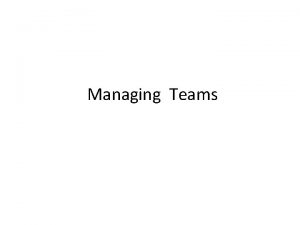TEAMS TEAM DEFINED TEAMS HAVE Two or More






























































- Slides: 62

TEAMS

TEAM DEFINED TEAMS HAVE: • Two or More Members • Specific Performance Objective or Recognizable Goal • Coordination Among Members is Required for Goal Attainment

TUCKMAN’S STAGES MODEL TEAM DEVELOPMENT • • • Forming Storming Norming Performing Adjourning Different interpersonal relationships and task behaviors at each stage

TUCKMAN’S STAGES MODEL TEAM DEVELOPMENT • Forming – Unclear Objectives, Lack of Commitment, Hidden Feelings • Storming – Arguments About Structure, Conflicts, Hidden Agendas • Norming – Review Clarifying Objectives, Opening Risky Issues, Establish Implicit or Explicit rules

Teams Progress Through Different Characteristics I. Caution & Inclusion Issues (Forming) II. Conflict is inevitable & necessary to establish trust. Development of unified set of goals, values, & operational procedures. (Storming) III. Willingness to cooperate, mature negotiations, & positive working relationships (Norming) IV. Productivity & task accomplishment (Performing)

HIGH PERFORMING TEAMS • Clear and Unified Understanding of the Goal • Shared Belief that the Goal Embodies a Worthwhile or Important Result • Appropriate Structure

TYPES OF TEAM STRUCTURE

CORPS’ PDT STUCTURE • Broad Objective is Problem Solving • Dominant Feature is Trust • Basic Structure is Focus on Issues • Clear Roles and Accountability • Effective Communication System • Monitoring Individual Performance and Providing Feedback

TEAM FAILURE # 1 Reason: Loss of Focus Where the Team Had Raised Or Allowed To Be Raised Some Other Issue Above the Team’s Performance Objective – Problems Complex – High Degree of Collaboration – Often Intense Concentration Required

GREATEST THREATS Politics and Personal Agendas are the Greatest Threat to Goal Clarity. – Lost Focus – What’s In it for Me vs. Team Objective – Once Started Almost Impossible To Stop

TRUST PARADOX Trust is a paradox in human communication. One can trust or distrust but one can never know for certain…

TRUST AND DISAPPOINTMENT

TRUST Trust is Produced in a Climate That Includes: – Honesty – Openness – Transparency – Consistency – Respect

Integrated Model of Group Development - Stages Recall the Integrated Model of Group Development that said: “Conflict is inevitable and necessary for the establishment of trust. ” Allowing development of the next stage -- willingness to cooperate, mature negotiations, and positive working relationships.

POP QUIZ An example of team “Norming” is: a. Members start questioning their performance b. Real issues begin to emerge; team sessions begin to be heated. c. The team is producing work as a team, resolving problems and getting the job done. d. Members learn about each other.

POP QUIZ An example of team “Norming” is: a. Members start questioning their performance

POP QUIZ The number one cause of team failure is: a. Improper Team Structure b. Lack of Management Support c. Team Members Too Technically Orientated d. Loss of Focus e. Interpersonal Differences

POP QUIZ The number one cause of team failure is: d. Loss of Focus

CONFLICT TO COOPERATION

CONFLICT • Conflict is Always Present in a Relationship • The Absence or Presence—Amount of Conflict does not Determine Relational Satisfaction, BUT • How Conflict is Handled Determines Relational Satisfaction

A trained psychologist can predict (95% certainty) if a couple will divorce within one year by observing their conflict behavior for 5 minutes!

CO VA • D NF LU a E • T y t L o • S erm da IC v elf ina y v TS l d a es efin valu lues itio es n alu AL R UT S C p U T u R t C e ST FLI n is s N io CO w situat itions • Ho e defin raints al t c l • Ro e cons c/physi thority ces r • Tim graphi wer/au f resou o o • Ge qual p ntrol o e o T S • Un qual c S e T e E • Un C R I tiv E L tan ral cal T F IN ON Subs cedu logi C • Pro cho • sy • P IP H S N O I T A S L T es E C p I y R t FL otions Stereo N n CO Em s or atio ng ption o r t unic m • S perce om r c s s i i • M r or m havio • Poo ative be g • Ne DAT • Lac A CO N k • Mis of Info FLIC r i • Dif nformat mation TS. i • Dif Views o on i • Dif nterpret n what i s a asse ssme tions of relevan t data nt pr oced ures

THREE BASIC RESPONSES • Avoidance – Can be Either Aggressive or Passive • Aggression • Integration

FEELINGS OF POWER IN A CONFLICT “Each person may firmly believe that the other person has more power” Conflict often escalates because each person believes they are in the low power position.

POWER IN A RELATIONSHIP • Dynamic • Collaboration – requires power sharing and realignment of power • Competition over power involves equalizing behaviors—”cutting down to size”-- and results in a downward spiral

CRITERIA FOR COLLABORATION • Low power participants must have opportunity for influence • Participants are being honest • Potential gains are worth the emotional and economic investments

FIVE CONFLICT STYLES • Collaboration • Compromise • Competition • Accommodation • Avoidance

COLLABORATION • High Energy Emotional Investment • High Concern for Self and Others • Search for Solutions: compromise assumes a “fixed pie, ” whereas collaboration looks for new solutions and addresses underlying concerns

BEHAVIORS FOR HANDLING CONFLICT • Recognize the Signs of Conflict and Don’t Fear Them • Begin With The Positive Intent • Center On a Specific Content Topic – Discuss Content – Avoid Value Discussions – Avoid Ego Content and Involvement

BEHAVIORS Cont’d • Keep An Open Mind and Look For Common Ground • Render Judgments on Facts and Merit • Consider Cultural Differences – Individualistic- Content and Outcome – Collectivist - Social Relationships and Process

PERCEPTUAL BIAS • Lake Woebegone: We view ourselves as above average • Actor/Observer Bias: we view ourselves as being cooperative and others as being competitive. (e. g. our behavior is driven by circumstances while theirs is driven by some attribute of their personality

BEHAVIORS Cont’d Finally, if Possible Prearrange Conflict Management Procedures – There is Always Conflict – Doesn’t Matter How Much Conflict is Present – How Conflict is Handled Determines the Health/Strength of the Relationship

POP QUIZ Which of the following is not a sign of an escalating dispute? a. Seeing the other person or group as an advisory or opponent. b. Lost awareness of caring about the impact upon the person. c. Denial of responsibility. d. Identifying areas of disagreement. e. Unwillingness to change.

POP QUIZ Which of the following is not a sign of an escalating dispute? d. Identifying areas of disagreement.

INTERESTS VS POSITIONS

POSITIONAL BARGAINING § The sides open the negotiations by taking fixed positions. § Charges and countercharges about the other parties’ behavior or proposals § The parties enter into a series of reciprocal concessions until a compromise is reached or the negotiations break off.

POSITIONAL BARGAINING • The absolute best outcome that positional bargaining can produce is a "compromise" • There's no potential for all parties to be fully satisfied with the outcome. • The adversarial posturing and unsatisfactory nature of the compromise may destroy the working relationship.

The alternative is to focus on interests. . . INTERESTS: Fundamental needs or conditions which people or groups must meet for continued survival, success or fulfillment

…instead of positions POSITIONS: How people would like to achieve their interests.

FOCUS ON INTERESTS § Even when positions appear mutually exclusive, parties' fundamental interests may be met in a number of ways.

INTEREST- BASED PROCESS § This approach is entirely consistent with the Corps Six-Step Planning Process § Just as the “zero-sum” assumption is a selffulfilling prophecy, experience shows that the belief that there is a solution that meets everybody's interests can also be a selffulfilling prophecy.

HOW DO YOU IDENTIFY INTERESTS • The key is listening closely to what people are really telling us • Most of the time we are just listening to get our arguments ready

ACTIVE LISTENING

LISTENING Listening is making sense out of what you hear. – Passive/Recreational Listening – Understanding – Evaluation – Listening to be Helpful – Active Listening: High Receive

WHAT HAPPENS WHEN PEOPLE FEEL RESISTED • They feel compelled to repeat whatever they felt was not acknowledged • They “escalate” -- more emotional language; voice tone sarcastic; volume increases. • They become more accusatory. • Their position becomes more rigid and fixed. • They become less open to alternatives. • They start seeing others as the enemy.

ROADBLOCKS TO LISTENING • • • Ordering, demanding Warning, threatening Admonishing, moralizing Persuading, arguing, lecturing Criticizing, judging, evaluating Interpreting, diagnosing

ROADBLOCKS TO LISTENING Continued • Advising, giving answers, offering solutions • Criticizing, disagreeing, contradicting • Praising, agreeing • Reassuring, sympathizing • Probing, questioning • Sarcasm, kidding, humor • Diverting, avoiding

Active Listening • Focus on what the message sender is feeling and thinking. • Rather than on the message receiver’s own feelings and judgments • Summarize in your own words what the speaker is feeling and thinking

ACTIVE LISTENING • Summarize, rather than judge, what the other person is saying • Summarize both feelings and ideas • Avoid lead-in phrases – “I hear you saying…” • Choose words that match the intensity of the feeling (transmitted via word choice, tone of voice, body language & other non-verbals. )

IDENTIFY THE POSITIVE INTENT OF THE SENDER Task Focus Get it Right Get it Done Aggressive Passive Get Along Get Appreciated People Focus

POTENTIAL BEHAVIORS WHEN POSITIVE INTENT IS BLOCKED Get it done – Speed up, Act vs. Reflect – Assertive & Controlling Get Along – Yes Person” Approval Seeking – Tongue Biting – Approval Seeking Get it Right – Perfectionist – No one else “gets it” Get Appreciated – Lack of Positive feedback – Attention Seeking; Exaggerates – Wants to be noticed

WHEN IT IS MOST IMPORTANT TO SUMMARIZE FEELINGS • Voice tone or word choice shows high intensity • Repeating the same point • When people say they are not being understood

WAYS TO ACKNOWLEDGE • Summarize your understanding of what people are thinking and feeling. • Record a summary on a flip chart and use as the record of the meeting.

WHY MEETING LEADERS USE ACTIVE LISTENING • If there is no acknowledgement, people feel incomplete and unsatisfied • Disagreeing causes escalation • Agreeing can alienate someone else in the audience • Active Listening creates an environment in which people begin to share interests, not just positions

UNDERSTANDING • Plan Communications by Anticipating Their Interests, Focus and Intent • Actively Listen • Get Confirmation


GROUP EXERCISE ROLE PLAY • Need Three Volunteer Actors – PM – Sponsor – Resource Agency Representative • Role Play a “heated” PDT Meeting • The Rest of the Group Should Observe as Active Listeners

GROUP EXERCISE ROLE PLAY • Active Listener’s Analysis – Identify Positive Intent for Each Actor – Were Non-Verbal Cues Consistent with Verbal Messages?

GROUP EXERCISE ROLE PLAY • Reenact The PDT Meeting • New PM Volunteer Actor – PM Uses Active Listening Techniques • Questions, Discussion, or Observations?

Active Listening • Focus on what the message sender is feeling and thinking. • Rather than on the message receiver’s own feelings and judgments • Summarize in your own words what the speaker is feeling and thinking

ACTIVELY LISTEN • Identify The Focus and Positive Intent • Blend Non-verbally: Bodily, Facially and Volume • Backtrack, Clarify and Confirm

ACTIVELY LISTEN • Speak To Be Understood – Monitor Your Non-Verbal's – Tell Your Truth – Be Ready to Listen
 More more more i want more more more more we praise you
More more more i want more more more more we praise you More more more i want more more more more we praise you
More more more i want more more more more we praise you Basketball is a team sport
Basketball is a team sport Aspire not to have more but to be more
Aspire not to have more but to be more The more i give to thee the more i have
The more i give to thee the more i have Collection of well defined objects
Collection of well defined objects Team's or teams'
Team's or teams' 6 faces 12 edges and 8 corners
6 faces 12 edges and 8 corners When two curves coincide the two objects have the same
When two curves coincide the two objects have the same Understanding work teams
Understanding work teams Understanding work teams
Understanding work teams Going native project management
Going native project management Team spirit becomes team infatuation
Team spirit becomes team infatuation The white team cheers for the blue team, just like
The white team cheers for the blue team, just like Implicit function grapher
Implicit function grapher The more you take the more you leave behind
The more you take the more you leave behind The more you study the more you learn
The more you study the more you learn Examples of newton's first law
Examples of newton's first law Knowing more remembering more
Knowing more remembering more More choices more chances
More choices more chances Human history becomes more and more a race
Human history becomes more and more a race Clemson wrestling
Clemson wrestling Can an atom have more neutrons than protons
Can an atom have more neutrons than protons Can an atom have more neutrons than protons
Can an atom have more neutrons than protons Can an atom have more neutrons than protons
Can an atom have more neutrons than protons Shapes that have smooth even edges and measurable
Shapes that have smooth even edges and measurable Recognizing parallel structure
Recognizing parallel structure Cornell cs 4414
Cornell cs 4414 Lang stair & rail inc
Lang stair & rail inc Why does new guinea have more species of birds than bali?
Why does new guinea have more species of birds than bali? Created when a line becomes connected and encloses space
Created when a line becomes connected and encloses space Why have more fun
Why have more fun You have more potential than you think
You have more potential than you think How many shapes have more than one line of symmetry
How many shapes have more than one line of symmetry Every flight of stairs with four or more risers must have
Every flight of stairs with four or more risers must have Element name
Element name Banner headline in newspaper
Banner headline in newspaper Elements of music
Elements of music Pay per use monitor
Pay per use monitor Ability of two or more waves to combine and form a new wave
Ability of two or more waves to combine and form a new wave I think you should be more specific here in step two
I think you should be more specific here in step two Overlapping food chain
Overlapping food chain Error
Error Romeo and juliet act 1 scene 2 quotes
Romeo and juliet act 1 scene 2 quotes Comparative and superlative adjectives 2 syllables
Comparative and superlative adjectives 2 syllables In text citation apa with multiple authors
In text citation apa with multiple authors The struggle between two opposing forces
The struggle between two opposing forces Distance vs. displacement
Distance vs. displacement Exchange of ideas between two or more persons is
Exchange of ideas between two or more persons is Orientation of p orbitals
Orientation of p orbitals Roman jakobson communication model
Roman jakobson communication model One two three four time to go to school once more
One two three four time to go to school once more Repeating consonants at the beginning of words
Repeating consonants at the beginning of words Linear inequalities
Linear inequalities Words have meaning and names have power
Words have meaning and names have power Does congress have the power to stop mail on saturdays
Does congress have the power to stop mail on saturdays Past modals for judgements and suggestions
Past modals for judgements and suggestions Because you have rejected me i have rejected you
Because you have rejected me i have rejected you I have resolved
I have resolved Ideas have consequences bad ideas have victims
Ideas have consequences bad ideas have victims Have been to or have gone to
Have been to or have gone to Zoological riddles challenge
Zoological riddles challenge Modal + be + past participle
Modal + be + past participle


